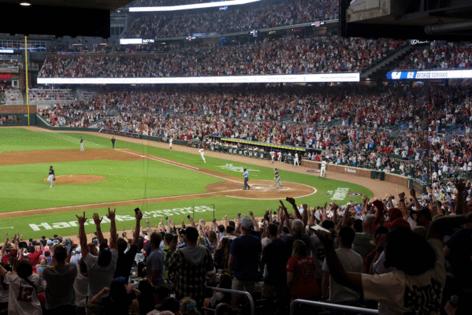Ken Sugiura: As Truist Park revels in All-Star glow, has it been worth it for Atlanta?
Published in Baseball
ATLANTA — Eight years after its opening, the Braves get to show off Truist Park and The Battery Atlanta to the baseball world.
Hosting Tuesday’s All-Star Game “puts us in a position of great pride and joy, because we now get to welcome the entire baseball world to town to see what we’ve built and what we’ve accomplished and let them enjoy what The Battery can be during a special event,” Braves president and CEO Derek Schiller told The Atlanta Journal-Constitution last week.
Braves fans know all about the Cobb County mixed-use development — home to restaurants, shopping, entertainment, hotels and residential and office space.
This isn’t just a ballpark, and a great one at that. It’s also a place to gather (and spend money) before games, after games and throughout the remainder of the year.
My friend, Patrick Kelley, drives over from DeKalb County with his family to Truist Park and The Battery many times a year, even on nongame days. Like me, Patrick grew up outside Chicago. He gives it what I consider the ultimate compliment, favorably comparing the feel of The Battery with Wrigleyville, the energetic neighborhood surrounding Wrigley Field.
“I think they pulled it off,” he wrote to me in a text.
The Kelleys have a lot of company. The Braves have ranked in the top five in MLB in attendance each of the past four years. In 2023, the park and The Battery drew 10.3 million visitors, almost 80% from outside Cobb.
When the stadium opened in 2017, commissioner Rob Manfred went so far as to call it “a model for other organizations.”
Hundreds of sports organizations — other MLB teams, teams from other professional sports leagues, colleges — have visited Truist and The Battery over the years to take a closer look at operations, Schiller said.
This week is the Braves’ chance to show off.
“It stands as a paragon of the best possible sports and entertainment venue, in my opinion, in the world,” Schiller said. “And so we are excited to have Major League Baseball’s preeminent event to be here to showcase just that.”
And because it wasn’t quite paragon-y enough, no less than $40 million of capital improvement upgrades have been made to the stadium and The Battery in 2024 and ’25 ahead of this exhibition.
Just saying — if a few of those million could have gone been reallocated toward the bullpen, the Braves might not be so far removed from the National League postseason race.
“Look, we’re competitive, and we want our team to be doing better, and we’ve got a lot of season left,” Schiller said. “Hopefully, we can improve.”
As fans and dreamy-eyed baseball executives alike take in the All-Star spectacle, never let it be forgotten that the Braves have the taxpayers of Cobb County to thank.
Public funds accounted for $392 million of the up-front construction costs, in addition to $35 million in capital maintenance over 30 years, according to past AJC reporting. You’ll remember that the deal was done in private, giving taxpayers virtually no say over this use of their tax money.
The Braves and the county call it a home run. They boast that the stadium and associated taxes have generated a $3 million net gain for the county’s general fund, creating the picture that the development is creating more tax money for the county than it is absorbing.
It is technically true. Taxes designated to cover the stadium’s debt service payments, along with the team’s $6.1 million annual rent, now cover the annual cost, which in 2024 was $22.5 million.
But it’s not as if all of the tax revenue is being generated by the ballpark or The Battery.
Businesses in the stadium’s Cumberland area pay extra property taxes that total $9 million on the logic that being in proximity to the development is a benefit. It might be the case in some instances, like nearby restaurants, but not as much for businesses like storage facilities, office buildings and mattress stores.
Another $4.6 million of the annual debt-service payment is paid for by a combination of hotel/motel tax and a car-rental tax for the entire county.
If the Braves want to take credit for helping generate the vast majority of those taxes or Cobb officials want to give it to them, they might want to do so out of earshot of the Cobb resident who isn’t a Braves fan, doesn’t go to The Battery and had to pay extra taxes for a rental car when their own car was in the shop.
J.C. Bradbury, a Kennesaw State economist who has studied publicly funded stadium deals — and, in particular, Truist Park — determined that Cobb taxpayers pay a significant amount annually for the stadium and The Battery.
“The analysis I did basically did find that, yes, the county does seem to be generating some extra revenue from people visiting through sales taxes, but it’s just not enough to cover that cost,” Bradbury said.
The Braves and Cobb officials see it differently.
“Unless you’re a fool, there is no doubt that The Battery and the ballpark are an overwhelming success for not just Cobb County and the metro Atlanta area, but also the state of Georgia,” Schiller said. “That is undeniable.”
Perhaps enough time has passed that not many people care anymore. And there are surely Cobb residents who agree with Schiller and are thrilled with how it’s turned out.
And maybe we should just keep our focus on what will hopefully be a memorable All-Star Week in the city’s sports history.
But if the Braves can just use some of that mixed-use development revenue to sign some free-agent bats in the offseason, it would be really appreciated.
____
©2025 The Atlanta Journal-Constitution. Visit at ajc.com. Distributed by Tribune Content Agency, LLC.







Comments